1lumen selects and reviews products personally. We may earn affiliate commissions through our links, which help support our testing.
Olight Warrior 3S Copper Special Edition review
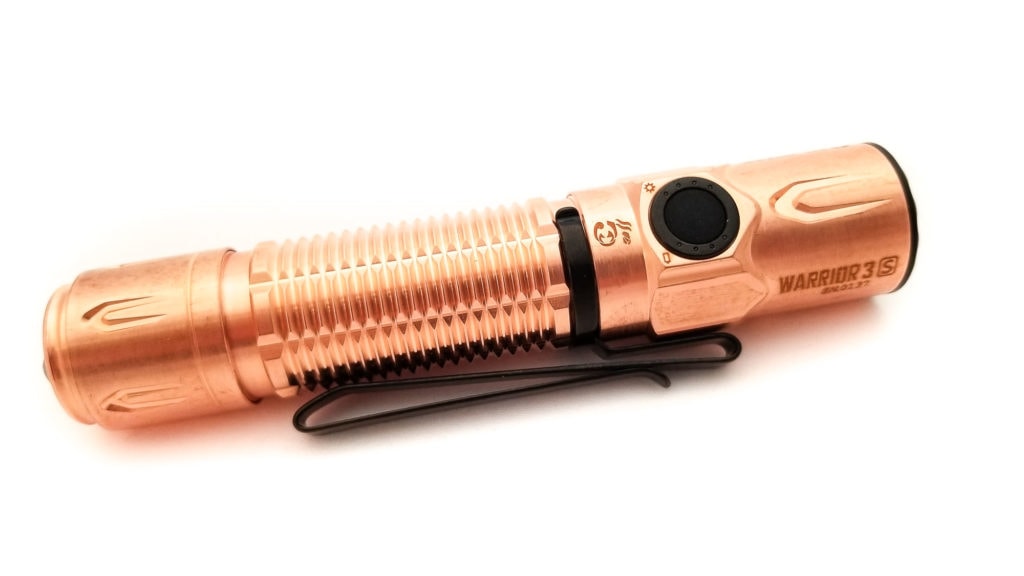
Olight Warrior 3S Copper Special Edition specifications
| Brand/model | Olight Warrior 3S CU |
|---|---|
| LED | ? |
| Max. Lumens | 2,300 lm |
| Max. Beam intensity / distance | 23,600 cd |
| Battery config. | 1*21700 |
| Onboard charging | Proprietary MCC magnetic charging |
| Modes | 5 |
| Blinkies | Strobe |
| Reflector | TIR opric |
| Waterproof | IPX8 |
| Review date | July 2022 |
Introduction:
If you’ve been following the flashlight hobby for any amount of time, you’ve probably heard of Olight. No surprise since they have earned some considerable cred with enthusiasts and professionals with an eclectic lineup of lights and outdoor tools and gear. Moreover, Olight also maintains a strong presence with police, military, first responders and tradespeople who put their Olights to work every day. A great trait, and something that sets Olight apart from the competition, is their special and limited editions of existing products, with special colors, materials, and designs.
Today I’ll be taking a look at a stalwart member of their tactical-use product line, the Warrior 3S. However, I won’t be reviewing just any Warrior 3S, because as part of their Summer sale, they’ve released some special flavored Warrior 3S’s, part of their Elements lineup consisting of Water, Air, Fire, Earth, and a special 5th Element. I reviewed the titanium Water version (awesome, by the way), and Olight surprised me with an additional, equally beautiful 5th Element version.
Package quality.
Olight packaging is something everyone should experience. Cracking open an Olight box reminds me of the days of yore when expensive mobile phones came in luxurious, often minimalistic packaging with magnetic closures and soft-touch materials. The two lights came in a very nice, very sturdy box with a lift-off top cover. Inside is the typical Olight yellow cover/ intro deal with prep instructions. Lifting that off reveals the light inside the holster with the accessories housed in a separate box.
- Olight Warrior 3S Limited Edition
- Olight ORB-217C50 21700 battery (loaded in the light)
- MCC charging cable
- Holster
- Manual
It’s a complete kit with all the necessities which is nice so you don’t have to buy anything, and this is especially important due to the fact that Olight bundles their proprietary (customized) batteries and MCC charging solution. The 5th Element light is pure, raw matte finish copper, and it was packed in a vacuum-sealed bag with an anti-oxidant packet to keep the finish patina-free for storage. The battery was isolated with a plastic isolator. Not including o-rings is kind of lame, and no lanyard is a drag as well. I wasn’t fond of the manual either. There’s zero explanation of how the UI works in the manual, so you’re on your own with that!
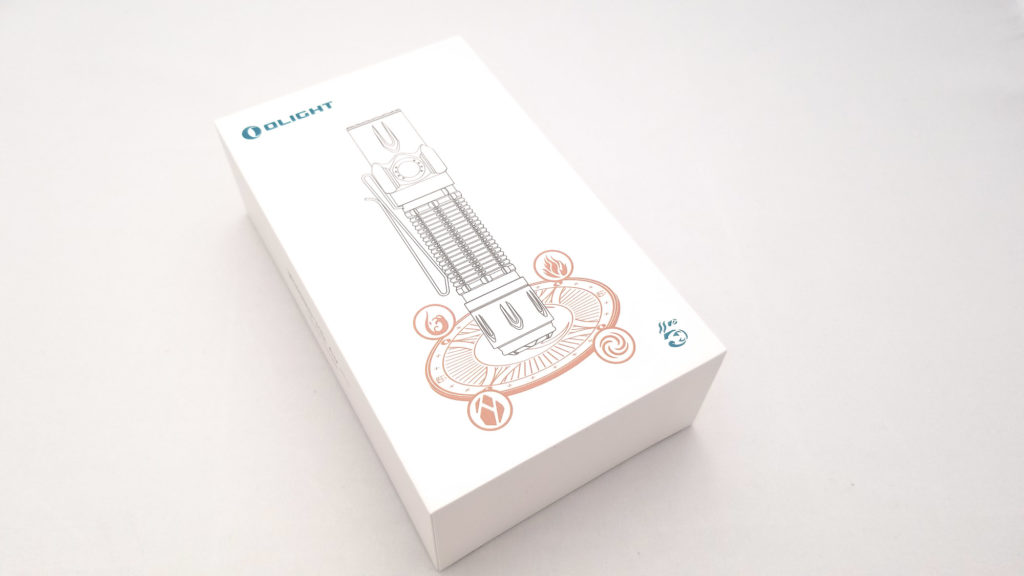
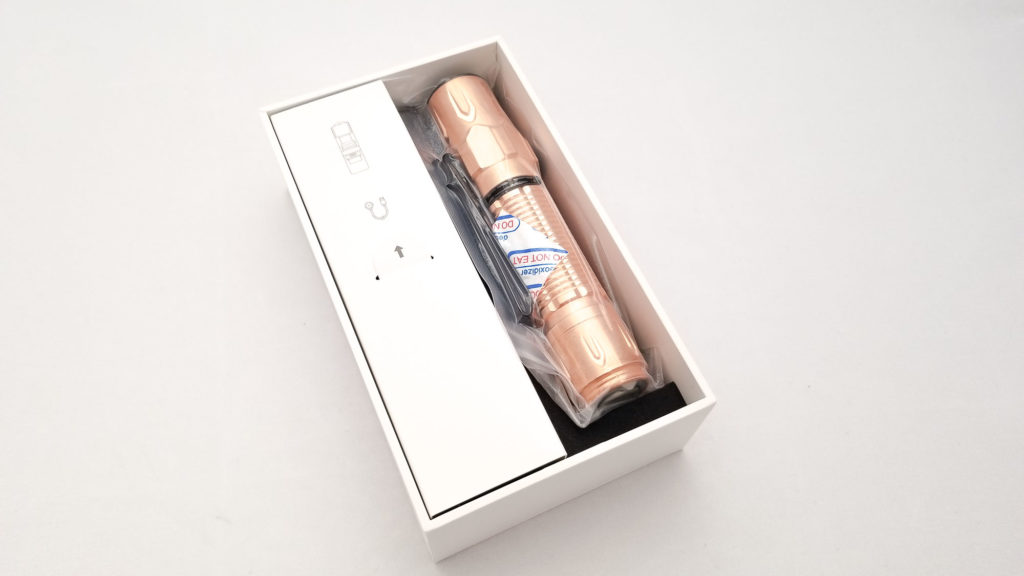
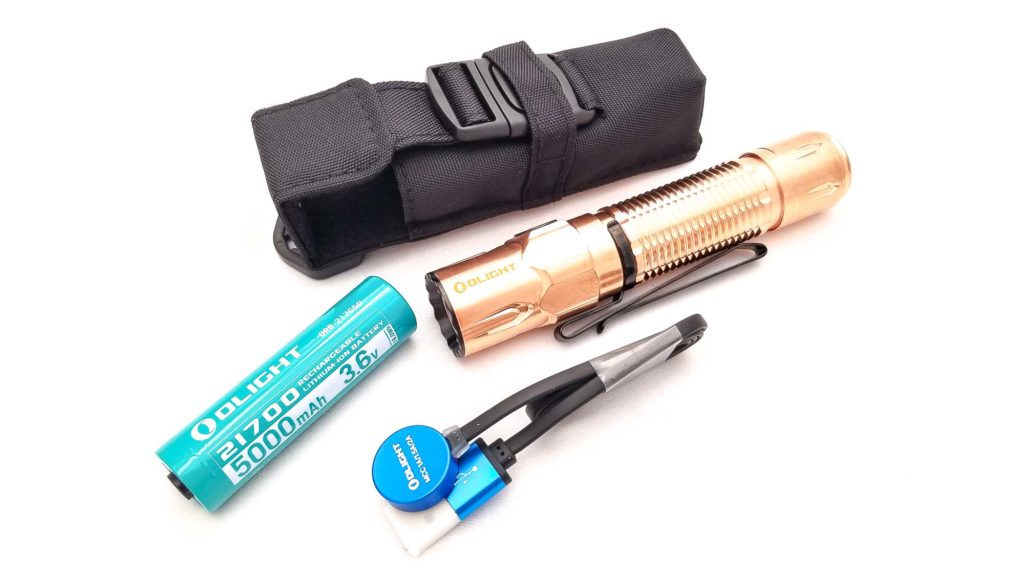
Flashlight in use
The Warrior 3S is a tactical-use flashlight, but it can also work as a general purpose or (if you’re ambitious) EDC light. It fits great in my hand, with the ultra-aggressive pattern on the tube that really bites into your hand for a super-secure grip. It’s also nicely weighted with a neutral balance that lends itself to easy handling in the overhand or underhand grip. For retention, the Warrior 3S has a detachable 2-way pocket clip for bezel up or down carry.
There’s two mounting points on the tube, one forward of the tailcap and one behind the head. It’s the same switchgear as the standard Warrior 3S with a front e-switch and rear dual-position e-switch as found on other Olight tactical lights. The front switch is for on-off and mode switching while the rear has a default setting for momentary use Medium and Turbo, and an alternate configuration for Turbo and Strobe mode.
The rear switch is metal and has a magnet embedded in it for the MCC charging interface. The front switch is bordered by 2 sets of 4 tiny green LED indicators around the periphery for mode and battery status, which is super handy and not gimmicky at all. The front switch has a rubberized cover and the action is very low with near zero travel. It requires a firm press, which is good for preventing accidental activation. There’s good feel and feedback.
The rear switch is a metal button and seems very pogo-y with a firm action and long travel. There’s a distinct click between the two positions though. I could not get the Warrior 3S to roll off my table, and tail standing is not recommended since the tailcap isn’t completely flat. The Warrior 3S can also be mounted to a long gun with the optional E-WM25 M1913 Picatinny rail mount and sROD-7 remote switch with quick-release magnetic lock.
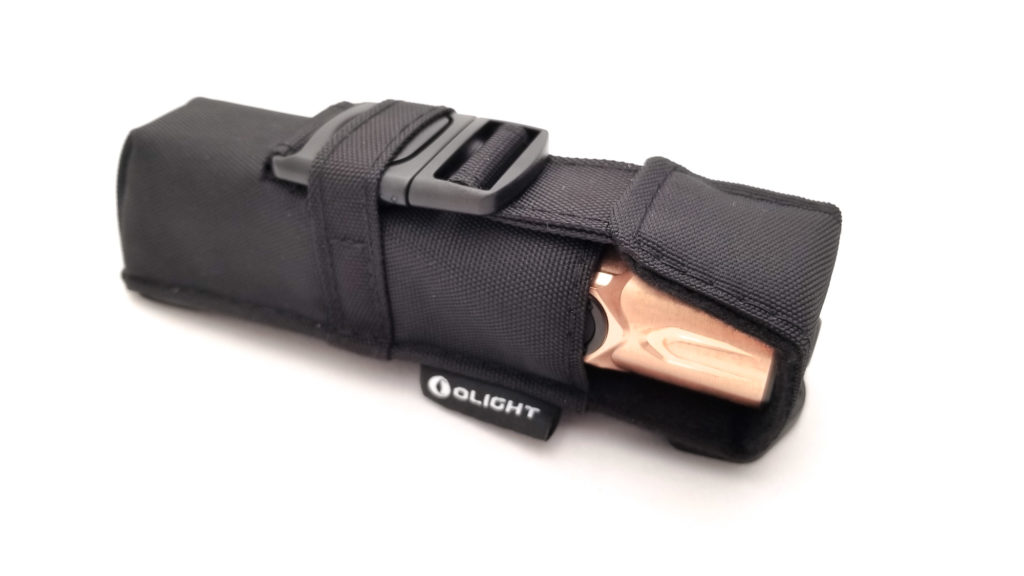
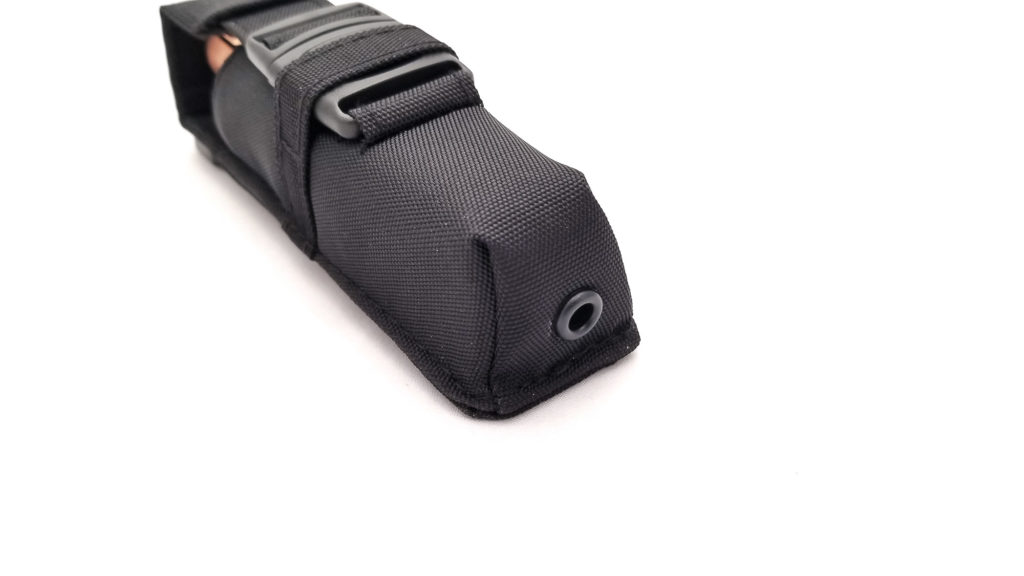
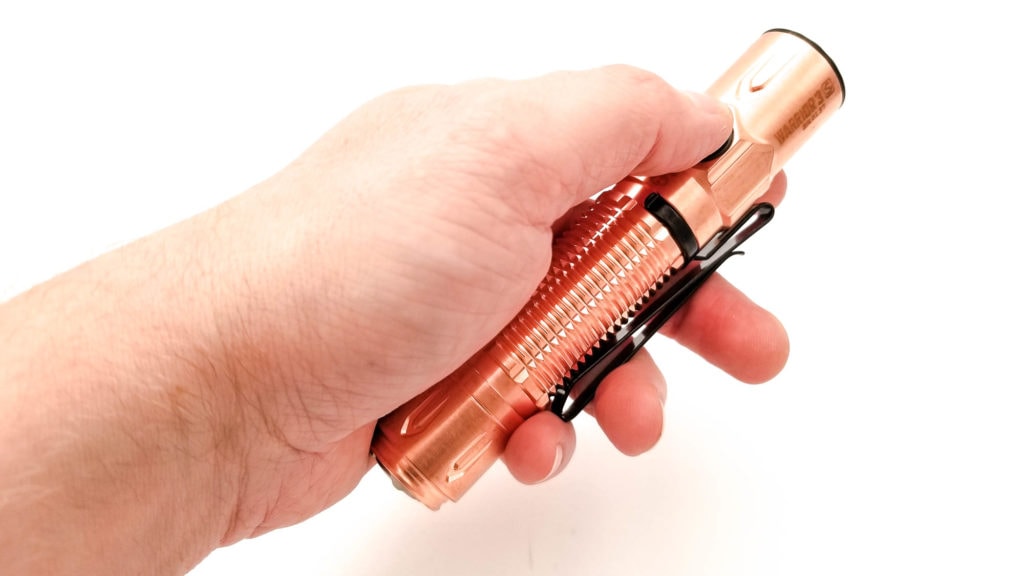
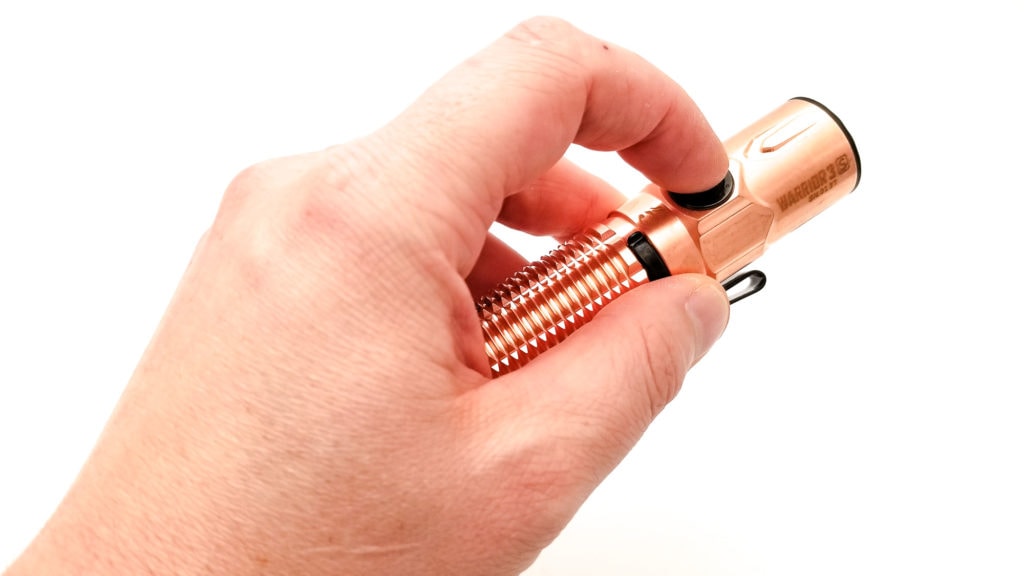
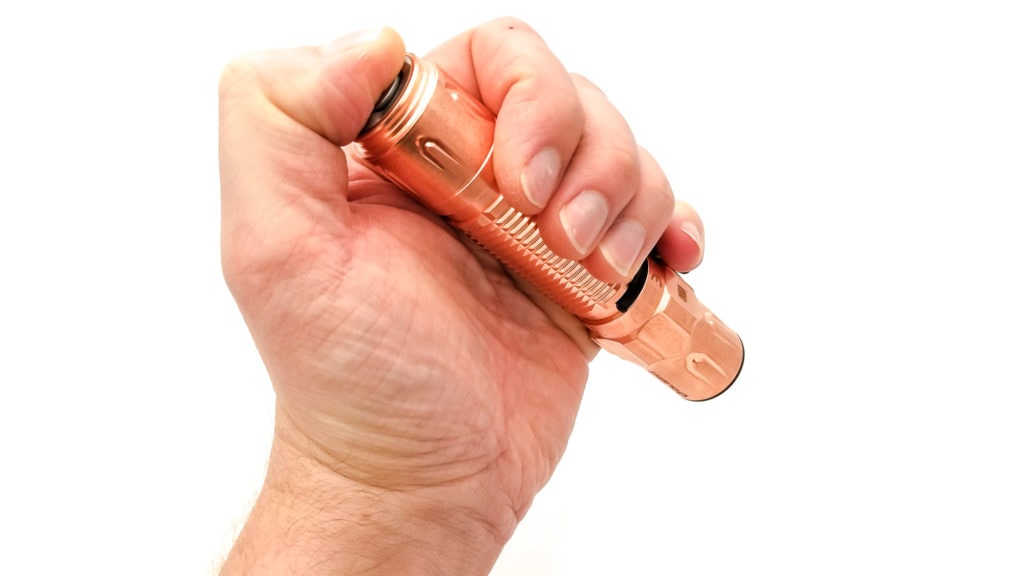
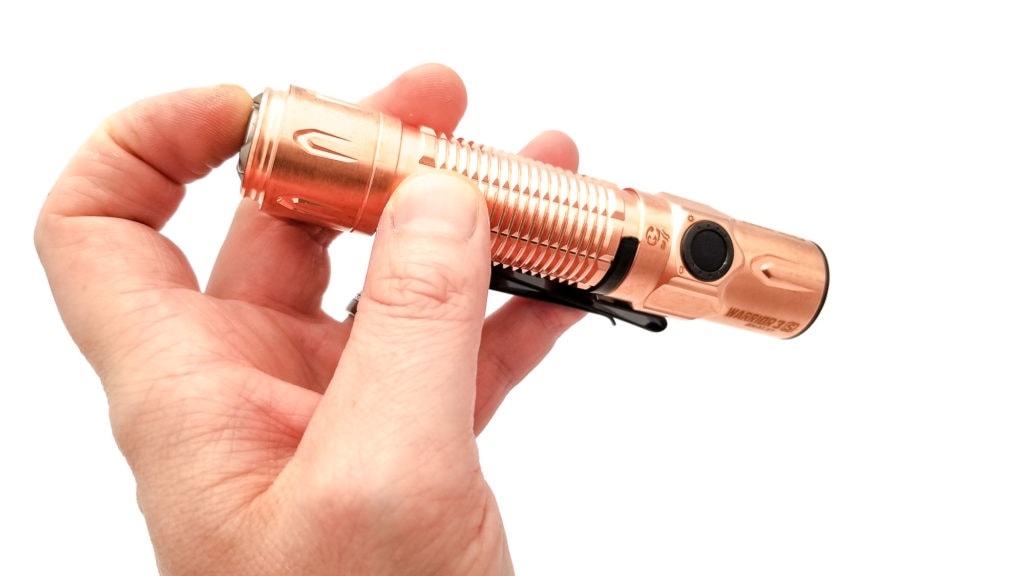
Build Quality, and Warranty
When buying an Olight you can be assured it will be a quality item. Every Olight I’ve reviewed has been top-notch in build quality, fit, and finish. The Warrior 3S Limited Editions carries that forward to a T. Pricing hasn’t been announced for the Limited Edition lights, but the regular Warrior 3S sells for about $120 US, which is very competitive with similar lights from Acebeam, Fenix, and Nitecore. The copper version goes for $139 outside the sale.
The Limited Edition lights are made from titanium for the 4 elements, and the 5th element version is milled from solid copper. Copper is an interesting medium for flashlights. It’s much heavier than aluminum or titanium, and has amazing thermal and electrical properties. The machining, fit, and finish are flawless with no misaligned parts, gaps, or blemishes. The edges are all chamfered and smoothed, and the silkscreen text and laser engraving are crisp and sharp with nice contrast against the brushed copper finish. The finish was oxidization and patina-free out of the box as well. The light is glued up so only the tailcap is removable. There’s a decent-size gold-plated spring spring on the driver side, and the tail cap has a spring-loaded button. Springs on tactical or pro-use lights are very important because they improve durability and add protection from recoil impulses and shock loads. There’s no signal tube, which adds additional durability. The copper version threads are sturdy, rectangular cut, and unlike the titanium version, were super buttery smooth. With a glued up body and single o-ring at the tail, Olight gives the Warrior 3S Limited Editions an IPX8 rating.
Olight’s warranty is one of the best in the industry: 30-day no-hassle returns and a 5-year limited lifetime warranty on most lights. Defective lights can be returned for repair within the warranty period, but the buyer pays for shipping. Olight covers the cost of repairs and parts. Even after-warranty support is generous with a 30% discount for a replacement item. Rechargeable batteries are covered with a 1-year warranty. Accessories such as pocket clips, holsters, filters, and lanyards etc. are not included under the warranty.
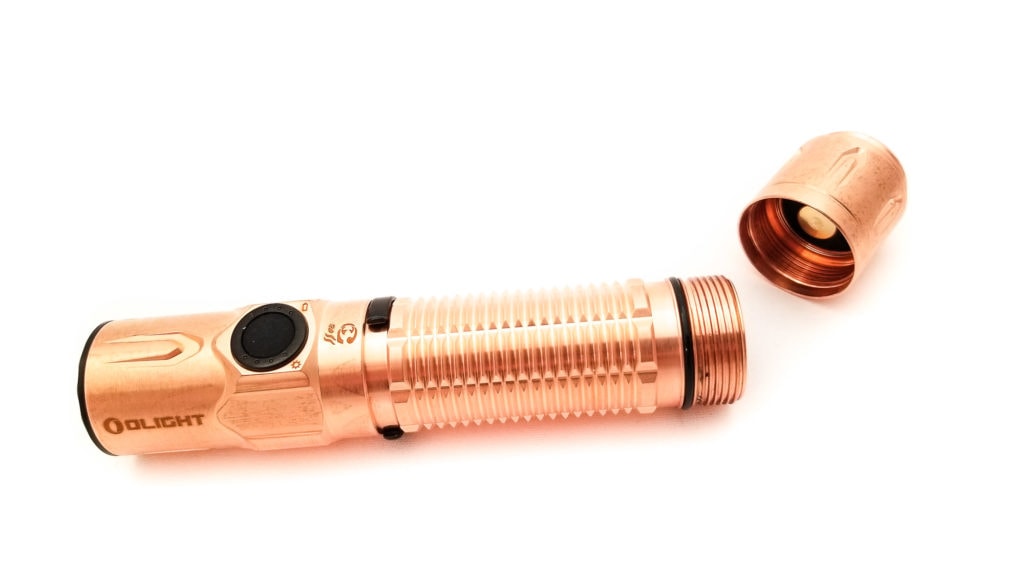
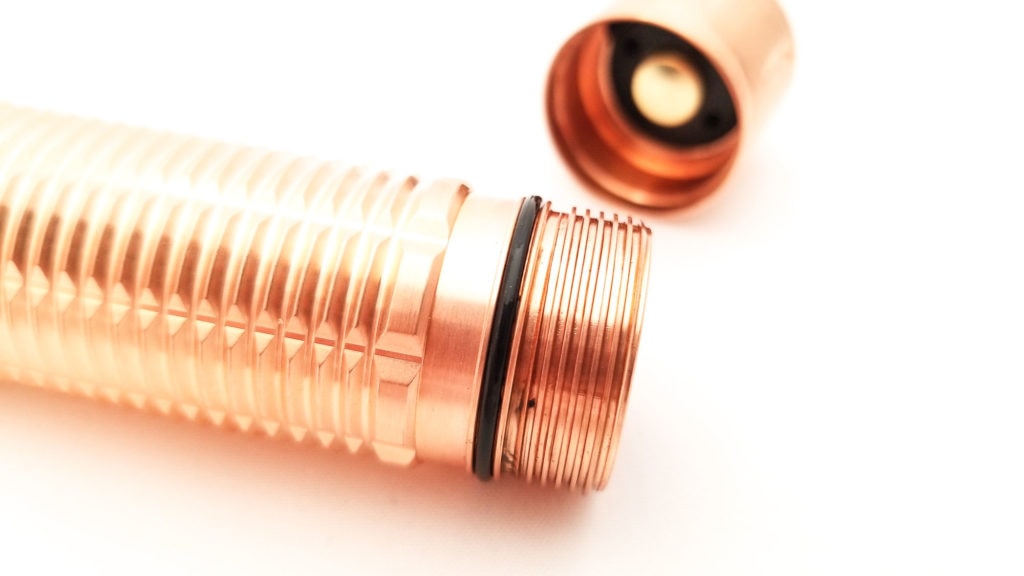
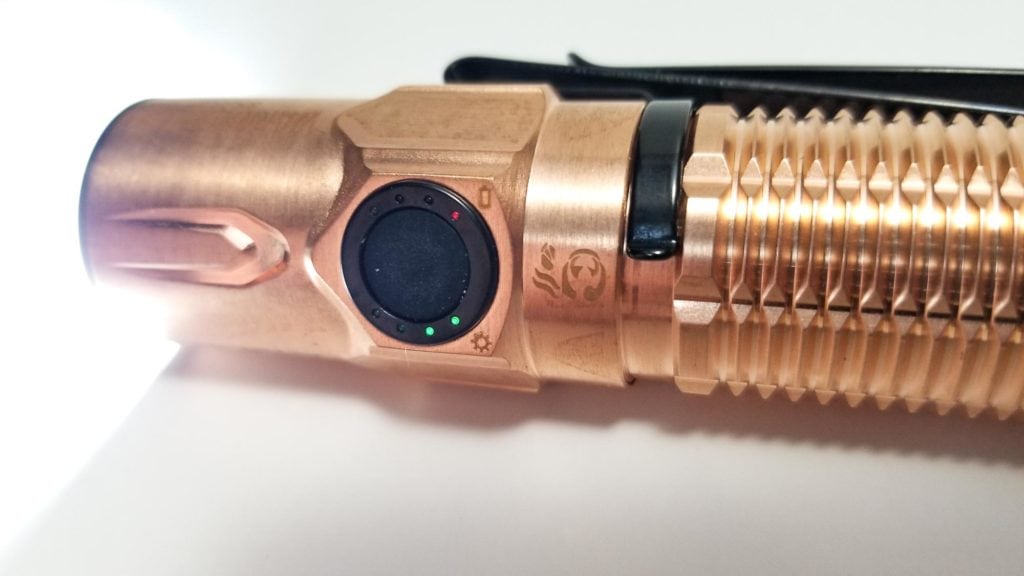
LED, Lens, Bezel, Beam, and Reflector
You don’t get LED specifics with Olight, and it’s the same silent treatment with an ambiguous designation of “High Performance Cool White LED.” That could mean anything from an XP-G3 to an ancient XM-L, but peeking inside the TIR lens, keen-eyed observers identify the LED as a Luminus SFT-70. This LED is pretty new, and has been featured in the Fenix TK20R V2 I reviewed. It’s a domeless quad-die 5050-size LED running on 6 or 12 volts, and no, it’s not a de domed SST70. It features a similar design to the SFT-40, with multiple bond wires embedded in the substrate. Although it doesn’t get as bright as the domed SST70, it throws better and has a more uniform beam and tint distribution.
The CCT is always cool white for the SFTs, and The Opple Lightmaster III concurs, with the tint right at 6433K and RA 68.1 on Turbo. On high the CCT is 6168K at 66.7 RA, so the tint drifts higher as output increases. The duv for Turbo is 0.0032 and 0.0062 for High. All Warrior 3S use a custom PMMA plastic TIR optic in place of a reflector, and the optic looks identical to the one in the Olight Odin. It’s missing a protective glass lens, but is protected by a finely-crenulated blackened bezel with the optic set back about 4 mm. Olight also incorporates a proximity sensor at the 6 o’clock position that dials back the output to Medium if an object is placed close to the bezel like the Fenix LR80R. This one can be disabled, so thanks Olight! The beam is similar to the Odin series with a very large defined hotspot surrounded by diffuse spill. The spill is dimmer than a reflector, so you don’t get as much side illumination, but it’s a very good general-purpose beam with plenty of reach.

Dimensions and size comparison
Dimensions:
| Olight Warrior 3 Cu dimensions | Millimeters | Inches |
|---|---|---|
| Length | 135 mm | 5.4 |
| Head diameter | 26.2 | 1.03 |
| Body diameter | 26.2 mm | 1.03 |
Weight:
| Olight Warrior 3 Cu Weight | Grams | Oz. |
|---|---|---|
| Without battery: | 233 | 8.2 |
| With battery | 306 gr | 10.8 |
Tactical flashlights size comparison
Group 1, tactical flashlights, left to right: Fenix TK20R V2, Olight Odin WML, Olight Warrior 3S Limited Edition Earth (copper), Olight Warrior 3S Limited Edition Water (titanium), Fenix PD36 Tac, Fenix TK16 v2.
Group 2 left to right: Olight Warrior 3S copper Limited Edition, Thrunite BSS V4, Thorfire C8
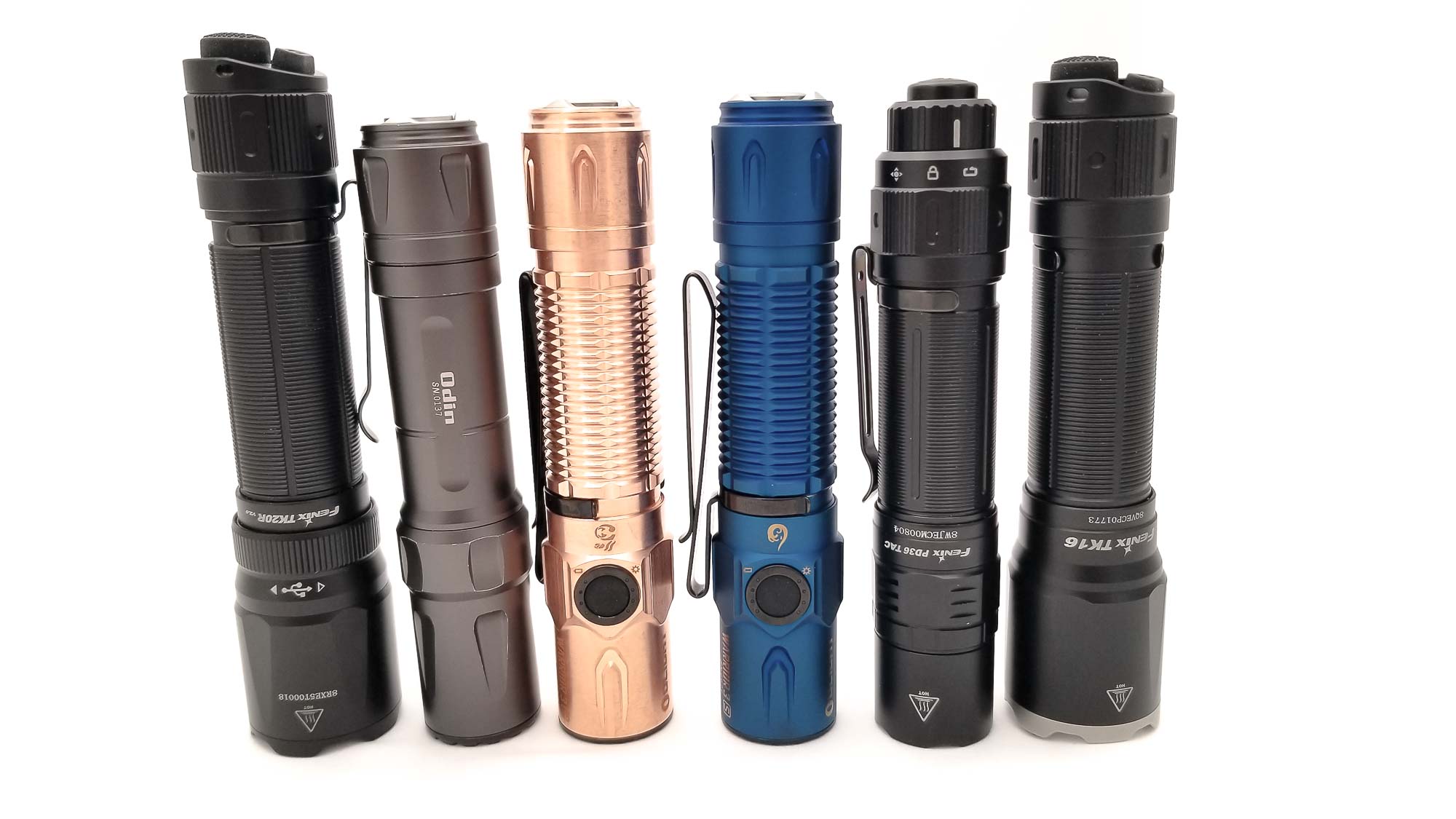
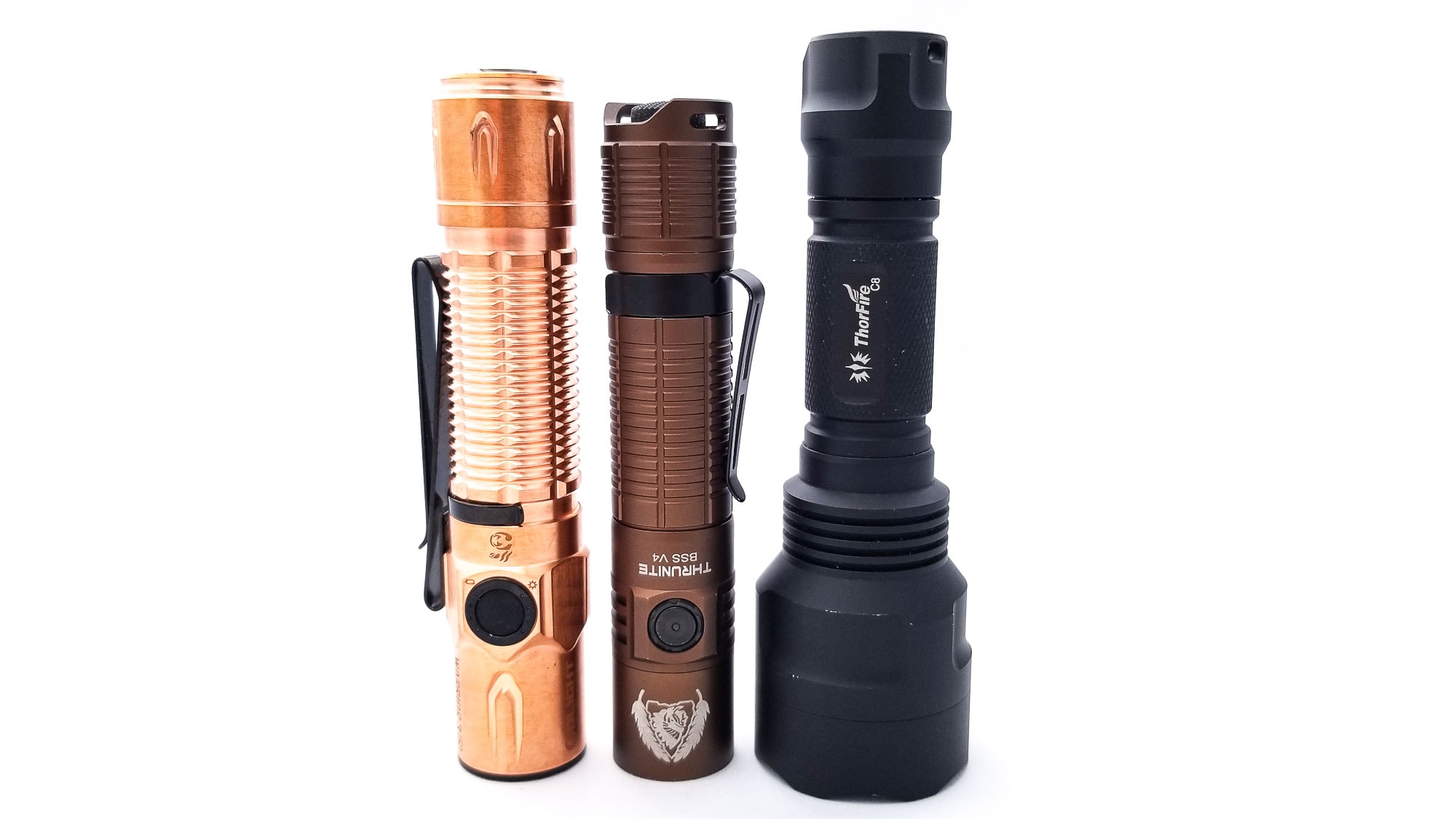
Driver & User Interface:
There’s no mention of the driver, but it’s definitely a boost driver since the SFT-70 needs 6 volts input and a single li-ion is 4.2 volts fully charged. Boost drivers are awesome since they’re constant current and the output doesn’t decrease as the battery drains like a FET driver. As long as the battery supplies voltage needed to keep the MCUs running, the output is laminar.
The UI is identical to the original Warrior 3S (and Warrior 3). The dual switches are commonplace on tactical-use lights and enable instant Turbo and Medium. On the Warrior 3S, they work independently of each other, with each controlling a different function set. Turbo and Strobe are available from the side switch and tail switch as well. There’s a second mode set available from the tail switch as well. The default mode is half press for Medium and full press for Turbo, and the second mode a half press for Turbo and full press for Strobe.
Available modes: Moon, Low, Medium, High Turbo, Strobe
From OFF:
- Fully press tail switch: Turbo (or Strobe in the 2nd mode set)
- Half press tail switch: Medium (or Turbo in 2nd mode set)
- Press and hold side switch: Moonlight
- Single click side switch: Turns on in last mode
- Double click side switch: Turbo
- 3 clicks: Strobe
From ON:
- Fully press tail switch: Turns off (Strobe in 2nd mode set is momentary only)
- Half press tail switch: Turns off
- Press and hold side switch: Cycles through modes L-M-H-L
- Single click side switch: Turns off
- Double click side switch: Turbo
- 3 clicks: Strobe
Mode memory:
- Yes
Shortcuts:
- To Turbo: Double click side switch
- To Strobe: Triple-click side switch
Low voltage warning:
- Olight eliminated the ultra-cool haptic (vibrating) LVP notifications found on the Odin series and other lights in place of indicator lights integrated in the side switch bezel. 4 lights >75%, 3 lights 75% to 50%, 2 lights 50% to 25%, 1 light 25% to 10%. When the battery is less than 10%, the last indicator turns red.
Strobe/blinkies
- Strobe, activated by triple clicking the side switch, or from the rear switch in the 2nd configuration mode with a full press.
Lock-out mode:
- Yes, electronic lockout is activated by clicking and holding the side switch from off for more than 2 seconds. It will switch to Moon mode, then turn off and the light is locked out. The single red indicator will light up if either switch is pressed.
PWM
- Fast PWM on all modes except Low, but not visible with the naked eye.
Proximity sensor
- The proximity sensor can be deactivated, only temporarily. When the light starts dimming in High or Turbo mode, you can do a double click to temporarily deactivate the proximity sensor. After you switch the light off, the sensor is re-activated at next turn on.
Additional info on the UI:
- This is a nicely-rounded out UI for a tactical or professional use light. It’s simple, easy to learn and navigate. The mode spacing is a bit abrupt from Low to High and Turbo though. I like the availability of the two mode sets for the tail switch as well, for a general-purpose mode and a true tactical mode with instant Turbo and Strobe on a single switch. Olight doesn’t mention any thermal regulation but its probably there. I do miss the haptic LVP though.
Batteries & Charging
Like the original Olight Warrior 3S, the Limited Edition uses a single 21700 li-ion cell. Olight bundles the ORB-217C50 5000 mAh 21700. I don’t know who makes this cell and there’s no CDR listed, but I expect it to handle at least 10 amps. Unfortunately (for some buyers), this is a “customized” battery (read: proprietary) with the positive and negative terminals at the top, so it’s (supposed) to only be used with other compatible Olights.
Even though proprietary is a dirty word with enthusiasts, I don’t really mind since the battery is high quality and warrantied for 1-year. It also protects the light (and the user), and helps meet the factory specs for output and runtime. Although it’s not recommended, the cell can be charged in an appropriately sized (these batteries are 75+ mm long) charger. They fit in my Vapcell S4+ and I got it to work with my Convoy L21B, Imalent R30C, and of course, the Olight Odin. It would probably work in other lights with long driver springs, but it’s at your own risk. For charging, love it or leave it, but you are stuck with Olight’s proprietary MCC charging solution. The cable has a standard USB type A on one end, and a magnetic connector on the other. There’s an LED indicator built into the strain relief that’s red for charging and green for charged/standby. It’s rated for 5V 1A or 5V 2A, so it will work with any USB wall wart charger and depending on the input, should charge the battery in about 3.5 hours. I saw about 1.5 to 1.7 amps during charging with a 2.4 A charger. The battery was consistently charged to 4.14 volts, and per Olight, the charging indicator turns green when the cell hits 95% capacity (roughly 4750 mAh), so 4.14 volts is about right.
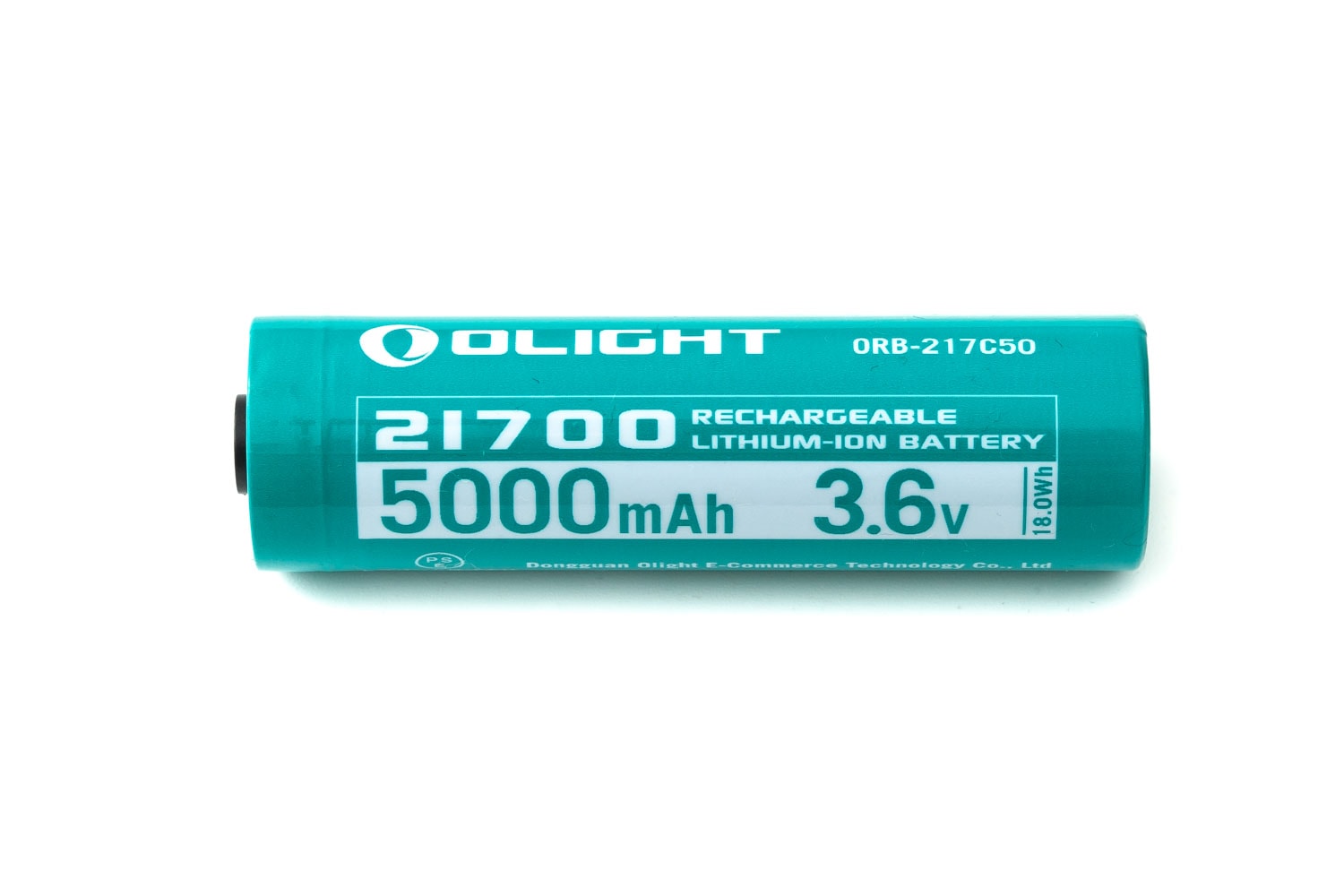
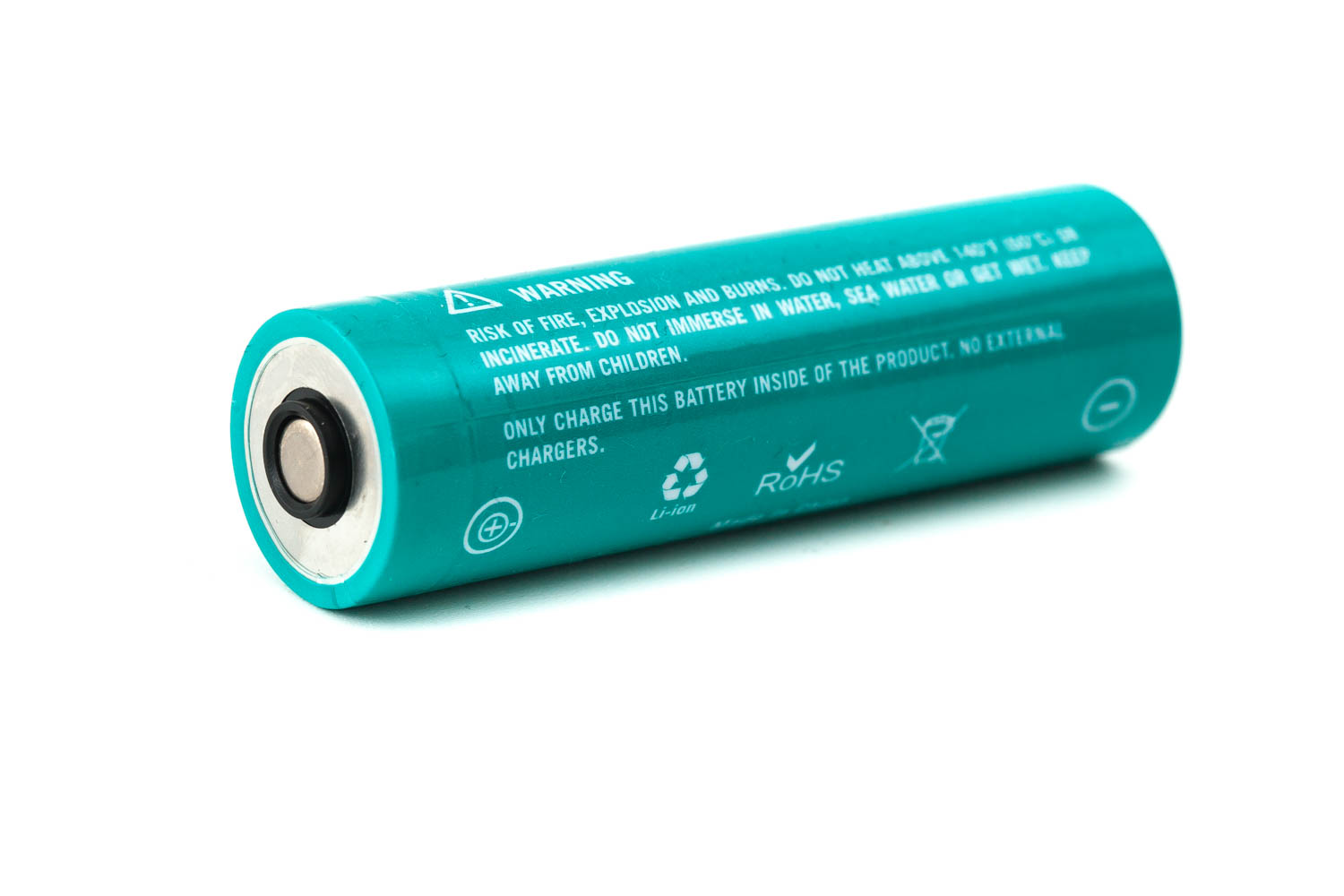

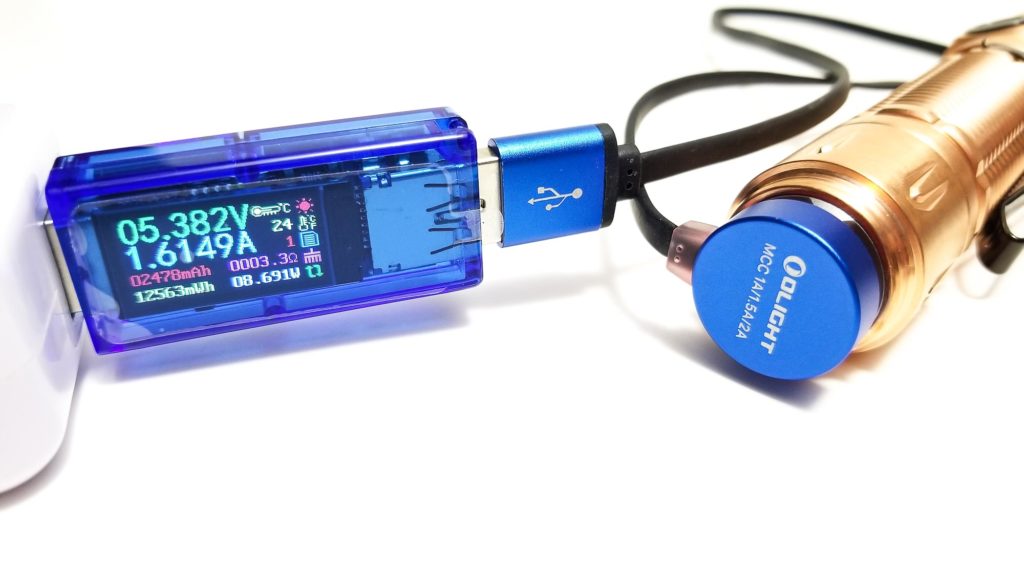
Performance test
Lumen measurements:
I tested the Warrior 3S Limited Edition in my 50 cm integrating sphere. I use a Digi-Sense 20250–00 datalogging lux meter, and the sphere has been calibrated with several lights of known output. Current is measured with my Radio Shack T-RMS multimeter with 16 gauge wire directly in the meter. No amp readings this time since the current path is isolated. I ran the test using the fully charged Olight 5000 mAh battery and tested Medium, High, and Turbo modes.
| Mode | Specs | turn on | 30 sec | 10 minutes |
|---|---|---|---|---|
| Moon | 1 | N/A | N/A | – |
| Low | 15 | 17.1 lm | 17.1 lm | – |
| Medium | 200 | 219 lm | 217 lm | 213 lm |
| High | 800 | 865 lm | 865 lm | 812 lm |
| Turbo | 2300 lm | 2571 lm | 2472 lm | 812 lm |
Moonlight is very low at 1 Lumen, and I believe it since I didn’t get a measurement.
Parasitic drain:
- N/A
Runtime graph
I tested the runtimes in my 50 cm integrating sphere. I use a Digi-Sense 20250-00 datalogging lux meter, and the sphere has been calibrated with several lights of known output. I ran the test using the fully charged Olight 5000 mAh battery and tested Medium, High, and Turbo modes.



| Mode | Specified | Measured runtime (ANSI) | Time till shut off |
|---|---|---|---|
| Moon | 1320h (55 days) | – | – |
| Low | 130h | – | – |
| Med | 13h | 12h 27min | 12h 27min |
| High | 3h 24m | 2h 52min | 3h 23min |
| Turbo* | 3h 20m | 3h 14min | 3h 16min |
The runtimes are very close to Olights specs, and not surprising since they’re lab-tested with the same battery. The output is very consistent throughout the runtimes, with step downs towards the end of the runtimes culminating in hard shut downs as LVP pulls the plug. The light stayed below 60 C for the entirety of the Turbo test, hitting 53.7C at 2 hours in. The light was not operable after any runtime test, and the shutdown is abrupt.
ANSI FL1 standards: The runtime is measured until the light drops to 10% of its initial output (30 seconds after turning on). This does not mean that the flashlight is not usable anymore. The last column shows how long the light actually works till it shuts off. If there is a + symbol, it means that the test was stopped at that particular point, but the light was actually still running. This happens on certain occasions, with certain drivers, firmware, or batteries.
Throw numbers: Peak beam intensity
I tested candela and throw using the Uni-T UT383S luxmeter indoors at 5 meters. Readings taken at 30 seconds. I used the fully charged Olight 5000 mAh battery.
| Mode | Specified | Candela measured | Meters | Yards |
|---|---|---|---|---|
| Moon | ? | N/A | N/A | N/A |
| Low | ? | 175 | 26 | 29 |
| Medium | ? | 2,225 | 94 | 103 |
| High | ? | 8,300 | 182 | 199 |
| Turbo | 23,000 | 26,050 cd | 323 | 353 |
Olight only lists throw distances for each mode, and a single candela figure of 23,000 cd, probably the Turbo spec. My figures are very close to the advertised throw distances.
Extra info: Peak beam distance according to ANSI FL1 standards: The calculated value of distance in meters at which the flashlight produces a light intensity of 0.25 lux. (0.25 lux is about the brightness of a full moon shining on an object).
Beamshots
I compared the Warrior 3S 5th Element Limited Edition to some other comparable flashlights, the Fenix TK20R V2, Fenix PD36 Tac, TK16 V2, Oligh Odin, Klarus XT11GT Pro 2, and Thrunite BSS V4.


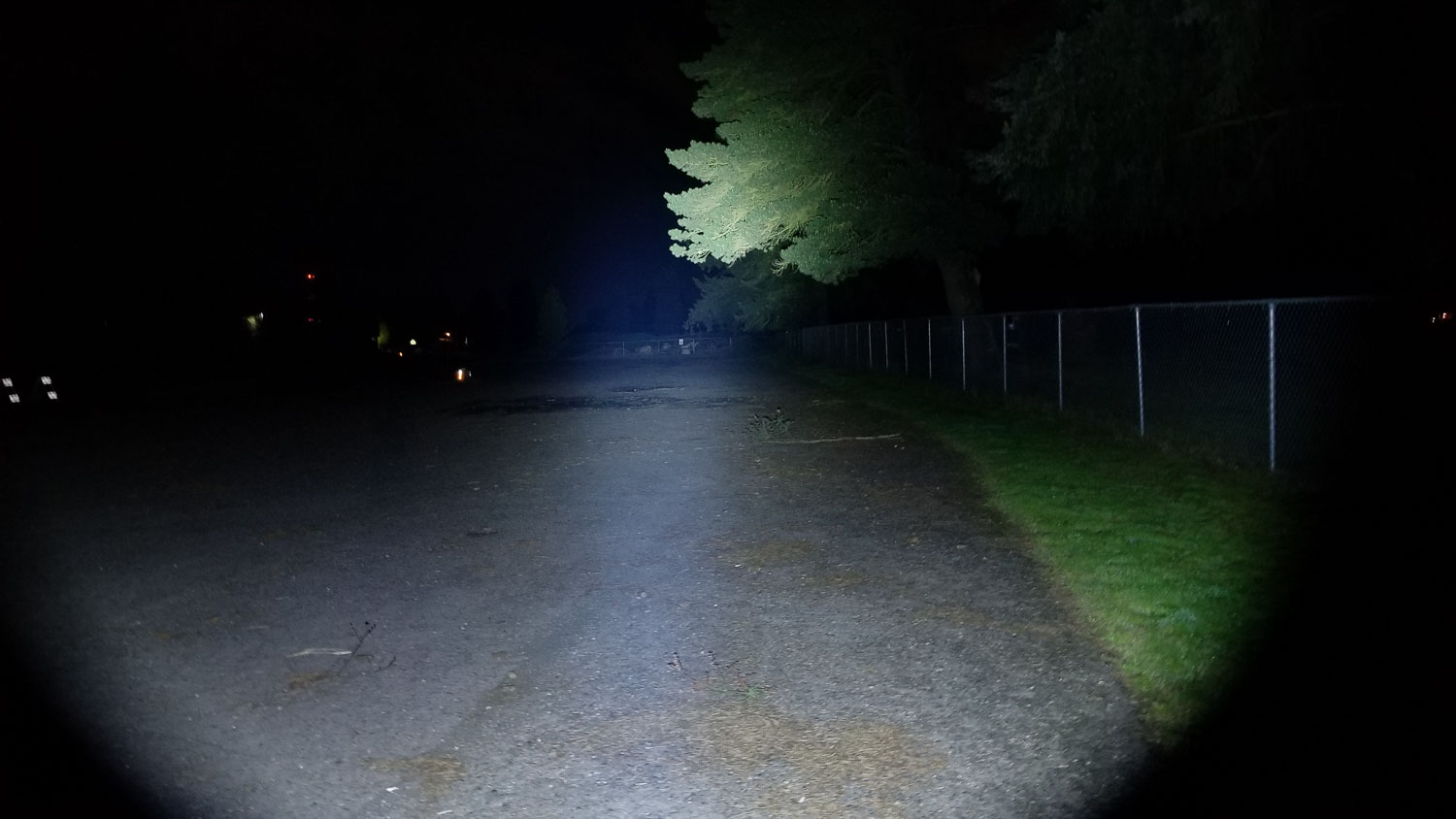
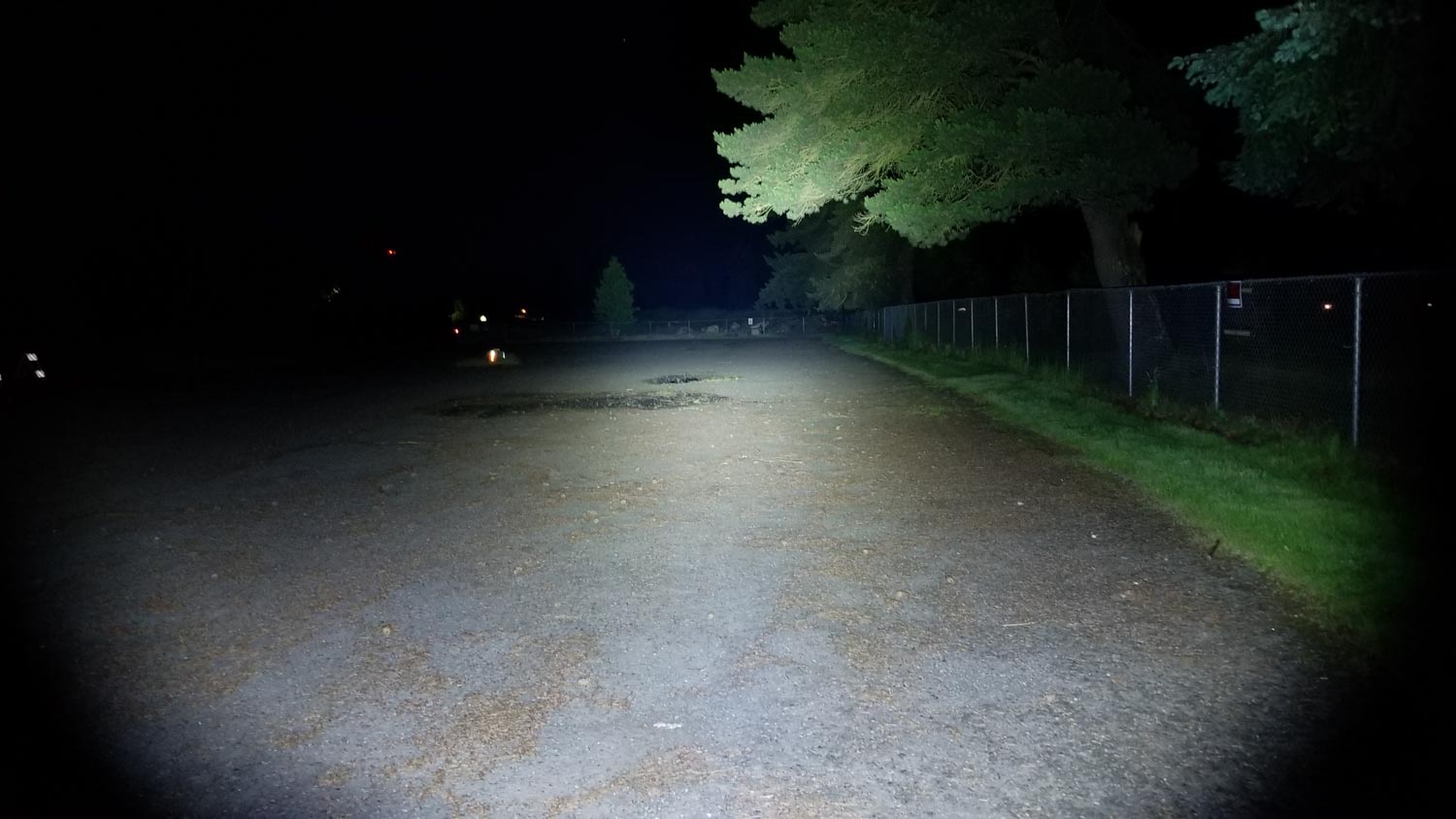
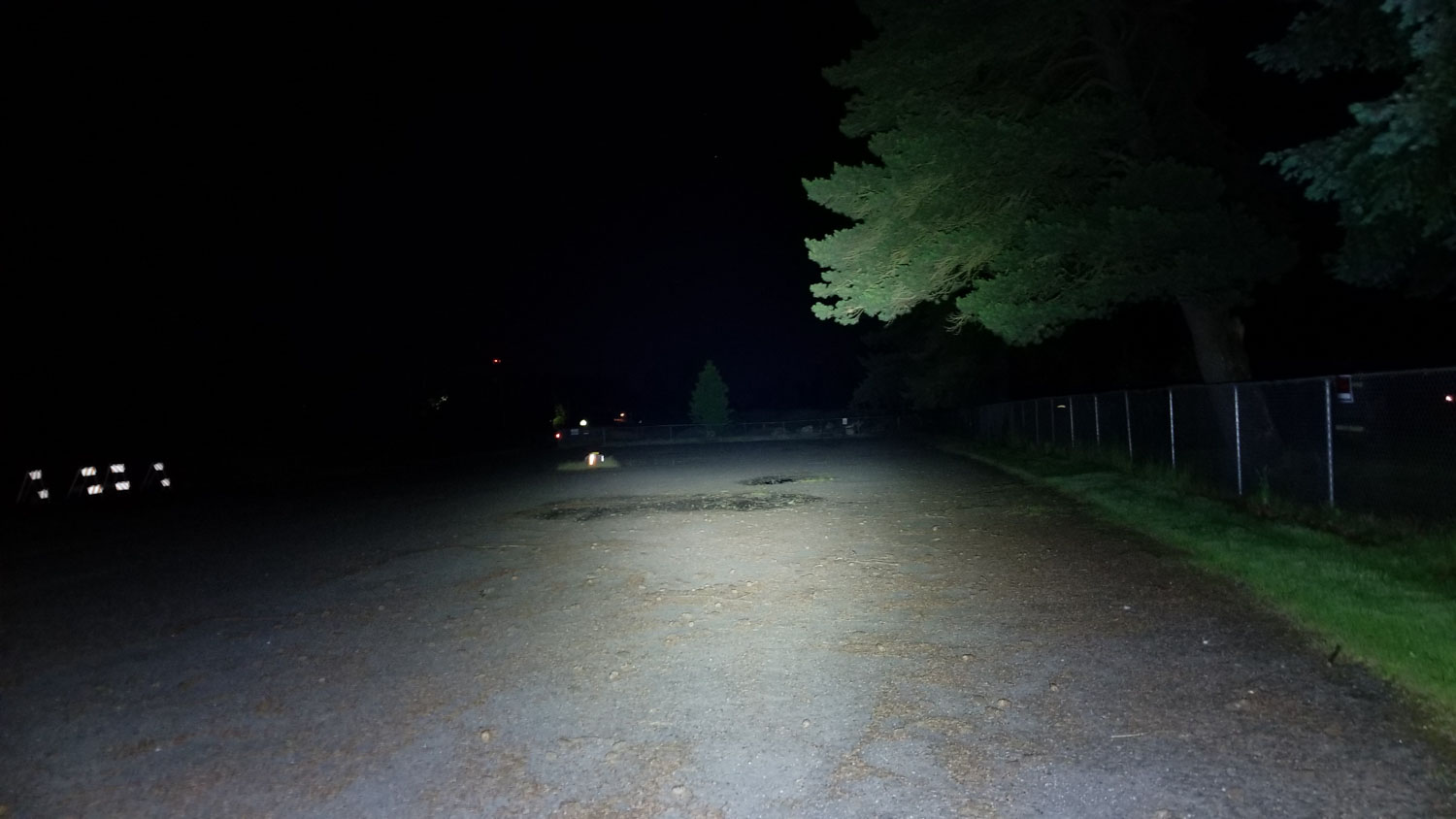
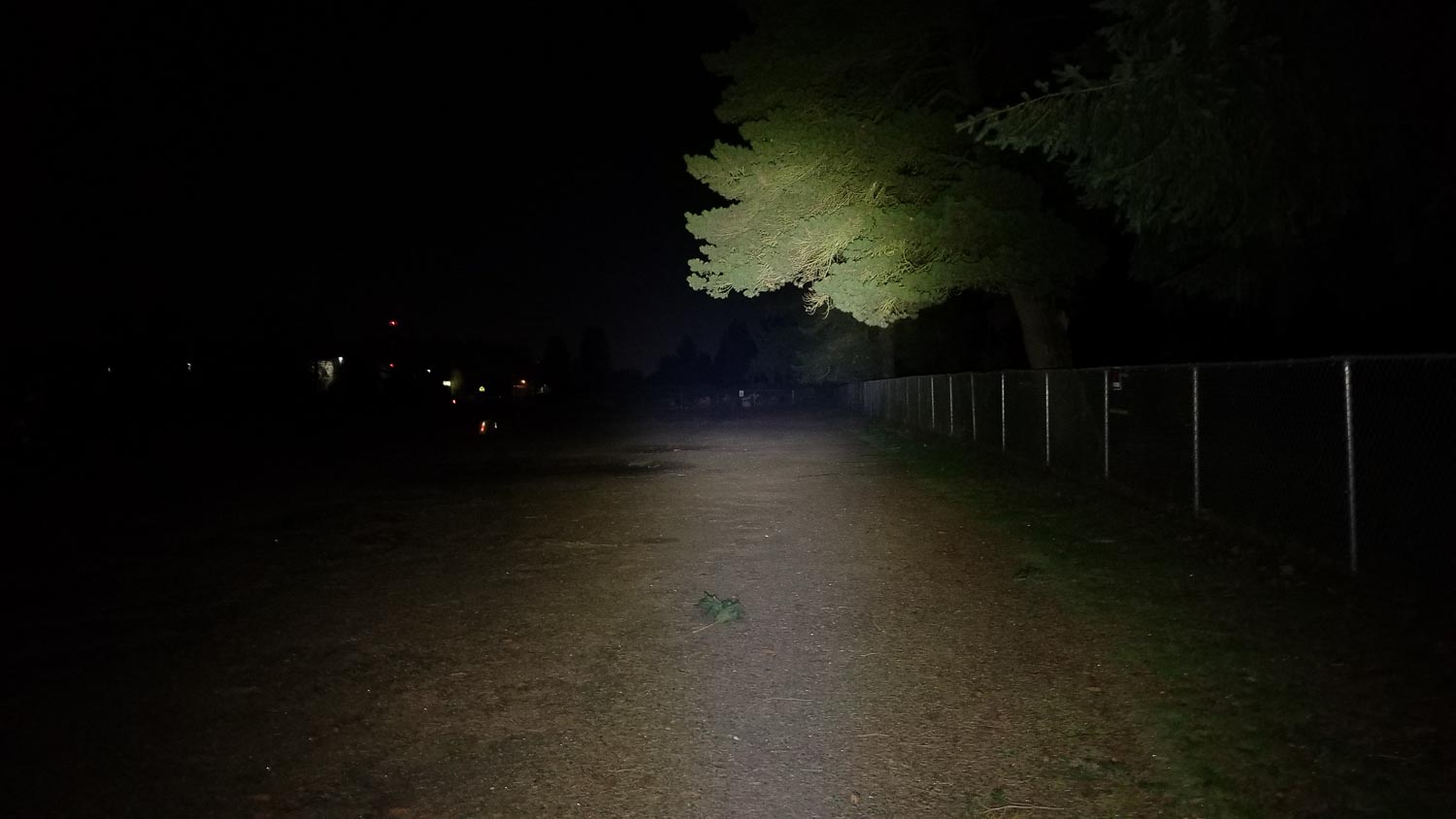
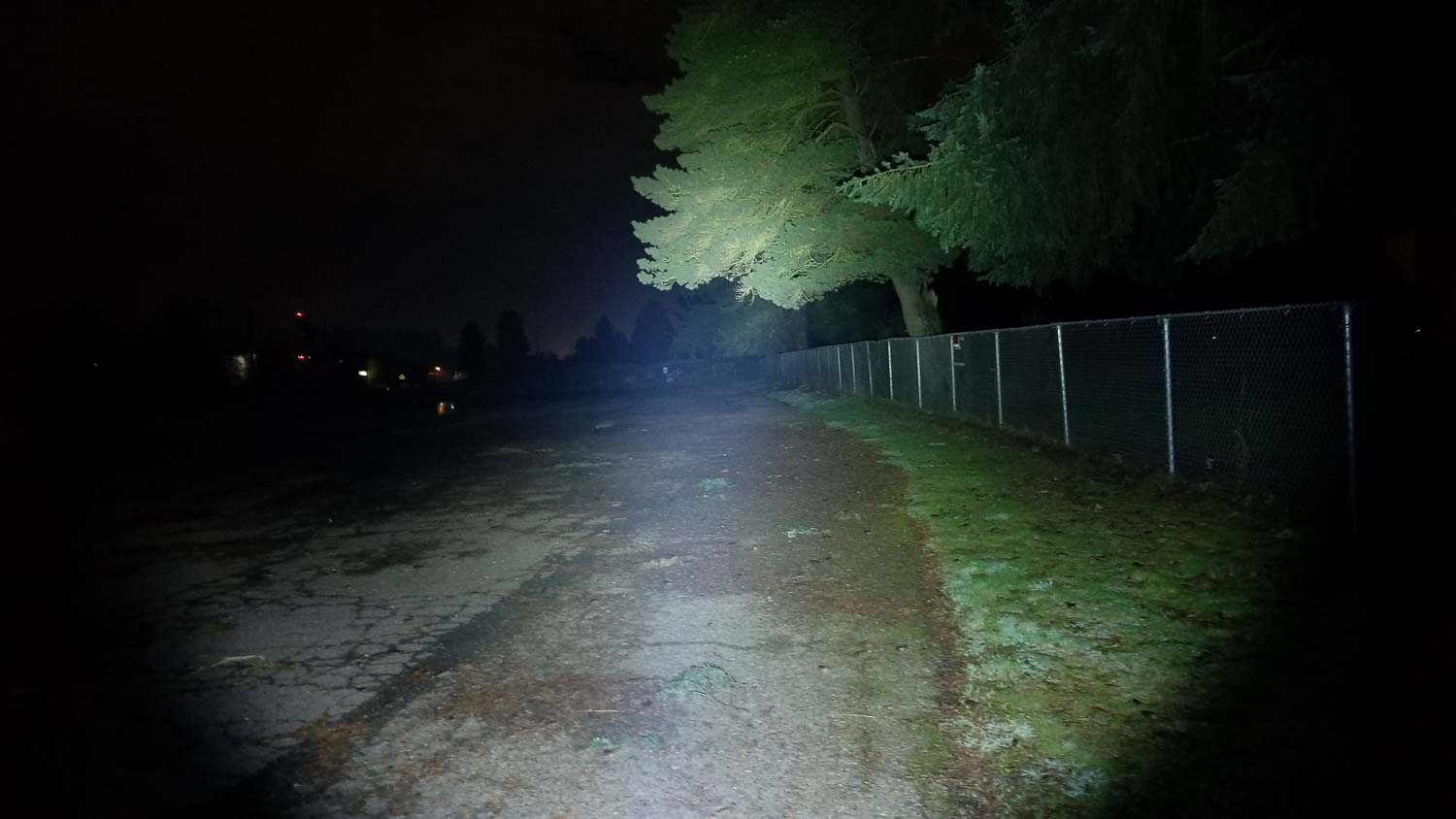

Disclaimer: This flashlight was sent to me for review at no cost by Olight. I have not been paid to review, nor have I been holding back on problems or defects.
Final Verdict
Pros
- Beautiful finish
- Awesome build quality
- Complete kit with battery and MCC cable
- High quality accessories
- Good performance
- Nice beam
- Simple UI
Cons
- Heavy!
- No vibrating LVP warning
Explanation on star ratings:
1: Avoid: my phone flashlight would be a better choice – 2: Poor: significant defect or issues; almost unusable – 3: Average: some defects or issues; but still usable 4: Good: recommended (minor issues) – 5: Great: highly recommended

5 stars: ★★★★★
I’ve tested 4 Olights up to this point, and even objectively speaking, have come away impressed each time. The combination of build quality, design, performance, and usability are hallmarks of a great flashlight, and the Warrior 3S checks off those boxes and is up there with the best from the major brands.
The Limited Edition 5th Element version is icing on the cake, and although copper adds nearly 2 ounces of weight over the titanium and aluminum version it sure augments the exclusivity and collectability factor quite a bit. Did I mention they look amazing? I’d imagine the copper version, like the titanium version, would be relegated to display pieces rather than EDC or working lights, but I am sure you could put either to work without any trouble. Shelf queen or not, once again, Olight impresses the heck out of me. 5 stars for the copper 5th Element Limited Edition.
Olight Warrior 3S CU discount
Use our exclusive 1lumen discount code to get an extra 10% off anything you order at Olightstore.com (USA). Coupon code: 1lumen
Copper version has been sold out. See links below for the aluminum version of the Olight Warrior 3S.
1lumen selects and reviews products personally. We may earn affiliate commissions through our links, which help support our testing.